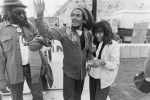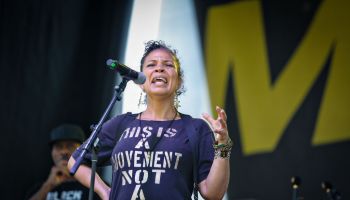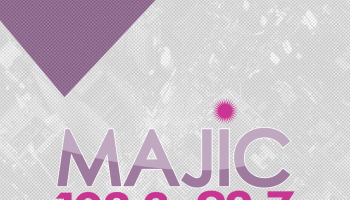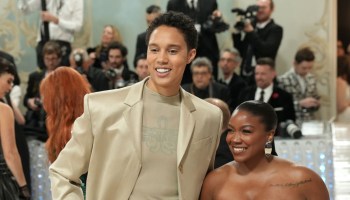VIA THE WASHINGTON POST:
The barista’s life is a frenetic one: pre-dawn openings, strung-out customers, the howl of steaming milk. Yet Liz Fedden got into coffee to unwind. Working as an Army nurse on a medevac helicopter ferrying wounded soldiers from Air Force bases to Walter Reed Army Medical Center, Fedden found a quiet corner of sanity at Murky Coffee in Arlington. “Pretty soon,” she recalled, “I was spending so much money there that the barista looked at me one day and said, ‘You know, if you just worked here, you could drink all this for free.’ ” That was three years ago. Today, Murky is no more, and she’s the “coffee boss” at Baked & Wired in Georgetown.
In her drainpipe jeans, with diving owls tattooed broadly across her chest and her hair pulled back in a chaotic bun, Fedden, 25, is easier to picture behind an espresso bar than on a landing pad. Pulling shots and pouring lattes, her hands follow an unthinking routine. On a busy morning, this meditative focus makes her a model employee. But tonight, at Washington’s monthly Thursday Night Throwdown, it makes her a fierce competitor.
The Throwdowns are guerrilla-style “latte art” competitions, local Olympics for the caffeine-addicted. Baristas from around town pack into a cafe after hours and, for a $5 buy-in, go head-to-head at the espresso machine.
The rules are few: one minute to pull a shot, steam milk and pour the perfect “rosetta” — a calligraphic fern leaf created as milk flushes espresso up to the surface of a latte. Sounds straightforward, but drawing liquid designs on a liquid canvas requires deft skill and steady hands. And steady hands require you to undrink the five cups of coffee you had at work that afternoon.
The lattes are quickly presented to a panel of judges and assessed for symmetry and intricacy. And as in March Madness, the winner moves on in the bracket. The take? A couple hundred dollars, a bomber of Dogfish Head ale and, of course, a pound of coffee beans.
The cash and glory are footnotes to the Throwdown, though. In truth, it’s a chance for the city’s geekier baristas to show off their latest pours. (Imagine District lobbyists getting together once a month to spin yarns about particularly lucrative earmarks they had secured.) It’s also the place to swap secrets and catch up on shop gossip. Here, at the intersection of coffee and pop culture.
“You can go to culinary school to be a chef,” mused Nicholas Cho, a patriarch of the city’s coffee scene, as he watched a semifinal bout play out last month, “but there’s no school for coffee. You can’t get a degree. So a Throwdown is like independent study for us.”
No one will lay claim to organizing the first Throwdown, because everyone agrees it had organic, accidental roots. “I’m 90 percent certain that people had been drinking and went back to the shop to see who could pour the best art,” said Ben Helfen, head barista at Octane Coffee Bar & Lounge in Atlanta.
Helfen, who has a rosetta inked on his right forearm, recalled an after-party in Washington two years ago. He had just won the Millrock Latte Art Competition, the Stanley Cup of pouring contests, at the 2008 CoffeeFest trade show, and the room was a veritable Who’s Who of coffee folks. A handful of baristas, three sheets to the wind, started fooling around, making macchiatos. “It started out as, ‘I can pour better than you.’ ” A crush of onlookers slowly surrounded the espresso machine. “I had this awesome feeling of being part of a real coffee community. We were pushing each other to do better, but there was camaraderie.”
The idea of regular, but informal, latte art competitions clicked with him. When Helfen got back to Atlanta, his shop began hosting weekly gatherings. He called them “Thursday Night Throwdowns.”
The name stuck. Today, coffeehouses in more than a dozen cities host Throwdowns every month. They’ve spread as far as Rio de Janeiro. This winter, baristas in New York and Washington went head-to-head via the Internet. Using Flickr, contestants uploaded photos of their pours; judges in Portland, Ore., Seattle and Philadelphia posted comments and gave instant rulings. (For the record, the District’s baristas note, they crushed the competition.)
Because shops make an effort to publicize them, the Throwdowns draw in curious customers and passersby as spectators as they unfold over an hour or two. “It really gives coffee professionals that ‘nerd time,’ for lack of a better term,” said Helfen. “Yet it can be a totally non-elitist thing.”
Lest the scope of the nation’s latte art scene be overstated: It’s small. But in Washington, where wonkishness runs in the tap water, baristas treat the craft of pouring a latte with gravitas. While it’s purely aesthetics that count at a Throwdown, attention to detail comes out in taste, too. When espresso’s rich texture and complex taste profile get full billing, a well-made latte suddenly becomes much more than a morning caffeine injection.
“It’s about focusing on coffee, rather than cute names, syrup or sprinkles,” said Rasheed Jabr, who opened Filter Coffeehouse and Espresso Bar in Dupont Circle this month. He’s personally training his own cadre of baristas, “from all walks of life,” and with measured intensity he sailed through the early rounds of the Throwdown before being knocked out. The appeal of specialty coffee, he said, “is that it can be back-to-basics or rocket science, whichever you want.”
If the baristas at latte art competitions are a bit self-serious, holding forth on the viscosity of heated milk or extolling the virtues of the six-ounce mug, it’s because their craft — more than just the flourish of a rosetta — almost became a lost one. Starbucks, in making the latte both pedestrian and quotidian, traded artistry for something more profitable: consistency. For all the grace under fire displayed by a midtown Starbucks barista at 8 a.m. on a Monday, few would speak of their work in terms of “craft.” It’s no secret that automated espresso machines reduce baristas to cup-shufflers and syrup-pumpers.
At a Throwdown, then, are those baristas at a growing number of independent shops who face a burr grinder and tamper rather than an LCD screen and choice of three buttons. Here, every well-poured rosetta is a minor victory and a point of pride.
Throwdowns are designed to be fast-paced and rowdy. With a premium on informality and drawing in the uninitiated, judges are chosen for their inexperience. No rubric exists. In the semifinals of last month’s Throwdown, held at the Counter Culture Coffee training center in Adams Morgan, Ryan Jensen, the incurably good-natured owner of Peregrine Espresso near Eastern Market, nearly bests his opponent by pouring a winking smiley face instead of a rosetta.
Cases of Pabst Blue Ribbon, cooling outside on the windowsill, disappear quickly. (Capitalizing on the latest inexplicable quirk of hipsterdom, PBR is the official sponsor of D.C. Throwdowns.) While competing baristas focus on the work at hand, the crowd mills about and forms a boisterous peanut gallery. A bracket on the whiteboard keeps track of winners and losers. Finally, 24 entrants are reduced to two finalists.
The championship pour ends up a duel between lithe blondes: Liz Fedden, whose trademark “triple rosetta” makes her the Shaun White of the barista underground, and Mid City Caffe’s Patrick Otthofer, 21 and rangy, whose rainbow headband and leather moccasins lend him the appearance of having just wandered in out of 1968.
Otthofer is jumpy. In several attempts, he has never won a Throwdown. On his toes at the espresso bar, he seems frantic, while Fedden’s moves are tightly controlled. But when their porcelain mugs hit the counter, it’s clear that he has won. He dances a puckish victory jig.
“I’m totally boosted,” he says, collecting an armful of prizes and a small trophy: an action figure, spray-painted gold. Then he ducks out to phone his mother with the news.
When he arrives home in Alexandria, she’s sitting in the living room, camera in hand, waiting to take a picture of the new champion.














